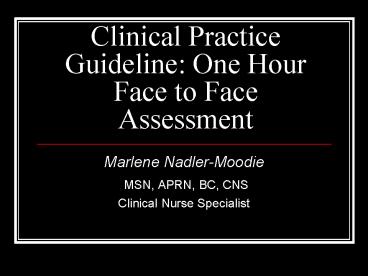Clinical Practice Guideline: One Hour Face to Face Assessment - PowerPoint PPT Presentation
1 / 24
Title:
Clinical Practice Guideline: One Hour Face to Face Assessment
Description:
3) Psychological State & Mental Status. 4) Legal and Ethical Considerations. ... assessing mental status and the psychological state of a patient in restraints. ... – PowerPoint PPT presentation
Number of Views:676
Avg rating:3.0/5.0
Title: Clinical Practice Guideline: One Hour Face to Face Assessment
1
Clinical Practice Guideline One Hour Face to
Face Assessment
- Marlene Nadler-Moodie
- MSN, APRN, BC, CNS
- Clinical Nurse Specialist
2
Introductory comments
- Future goal is a restraint-free environment
- What this presentation is and is not
3
Evaluation Includes (CMS rule)
- The patients immediate situation
- The patients reaction to the intervention
- The patients medical and behavioral condition
and - The need to continue or terminate the restraint
or seclusion.
4
Four Key Elements of Evaluation
- 1) Physical risks of loss of life.
- 2) Physical dangers and discomforts.
- 3) Psychological State Mental Status.
- 4) Legal and Ethical Considerations.
5
1) Physical Risks of Loss of Life
- Restraint Asphyxia
- Compromised respirations cause hypoxia
- Choking from positional airway compromise
- Aspiration potential from positioning, excess
salivation - Airway and chest obstruction due to positioning
and/or pressure - Obstruction of the mouth and nose
6
Physical Risks of Loss of Life-2
- Agitated Delirium/Acute Excited State
- Combination of agitation, aggression and
hyperpyrexia - Cocaine intoxication
- Adrenal catecholamine rush
7
Physical Risks of Loss of Life-3
- Cardiac Complications
- Cardiac compromised condition
- Arrhythmias
- Catecholamine release is followed by epinephrine
and norepinephrine output - Stress and exertion
- Psychopharmacological component
- Q-T Prolongation
- Cardiac Collapse
- Physical trauma
8
Warning of Cardiopulmonary Arrest
- Cessation of the struggle against the restraints
and shallow or labored breathing
9
Comparative risks related to positioning
10
2) Physical Dangers Discomforts
- Observe total physical positioning and condition
- Mechanical restraint checks
- Potential for laceration, bruising
- Body Position
- Potential for strangulation
- Clothing and bedclothes
- As above
11
Physical Dangers Discomfort-2
- Obesity-high risk associated with
- Multiple cases have been identified as having
negative outcomes - Nerve Damage
- Secondary to positioning and body/restraint
applications - Head Trauma
- Either self induced or sustained from others
- Pressure Ulcers
- Associated with prolonged restraint application
12
General Medical Condition
- Specific to this patient
- Consider ANY and ALL medical problems in the
context of the restraint episode and the
proceeding behavioral emergency - Vital Signs as soon as possible
- Review history and physical
- Current laboratory values
13
Environmental observations
- Room temperature
- Safety hazards
- Seclusion
- Room check
14
3) Psychological State Mental Status
- Observation and Assessment
- Condition prohibiting interview-observation is
used - Possible formal mental status via interview?
- Based on patients condition
- Return at a later time
- Comparative to previous and future
15
Communicating with the Team
- Ensure safety of staff
- Physical
- Emotional
- Discuss the events
- Proceeding the restraint
- During the restraint
16
Discontinuation
- Consider earliest termination
- Stability of the patient
- Criteria for release
- Debrief potential
17
4) Legal and Ethical Considerations
- Current laws, regulatory, facility policy
- CMS, Department of Health Regulations
- JCAHO
- Policies and Procedures
- Best Practices
18
Competency Demonstration
- RNs may now perform the One Hour Face to Face
Assessment of a Patient in Restraints for a
Behavioral Emergency - The following are suggestions for specific
verification methods for the competencies which
are needed to perform the evaluation.
19
Competency Demonstration for One Hour Face to
Face Competency Statement
Verification Methods
- Successfully demonstrates ability to assess for
the need for basic life support (BLS) - Successfully demonstrates ability to perform
cardio-pulmonary resusitation (CPR)
- Current BLS (or higher) Certification
- ____________
- (Expiration Date)
20
Competency Statement
Verification Methods
- Demonstrates ability to assess a variety of
potential physical problems related to patients
in restraints. - Demonstrates correct principles related to the
safe application of restraints.
- Passes Quiz
- Completion of 8 or 16 hour course Pro-Act, CPI,
in house or other____________ - completion date
21
Competency Statement
Verification Methods
- Applies critical thinking skills to assessing
mental status and the psychological state of a
patient in restraints.
- Exemplar
- Case Review
22
Competency Statement
Verification Methods
- Role models leadership skills working with and/or
leading the team when the use of restraints is
necessary. - Identifies the earliest opportunity for
discontinuation.
- Successful demonstration of skill observed by
supervisor. - Successful demonstration of skill, observed by
supervisor.
23
Competency Statement
Verification Metods
- Evidence of knowledge regarding regulations by
outside agencies and facility policy and
procedure.
- Passes Quiz
24
Summation
- Good luck in your restraint reduction efforts!
- Remember its a journey, a culture change and
doesnt happen immediately. - Contact me at moodienurse_at_yahoo.com































